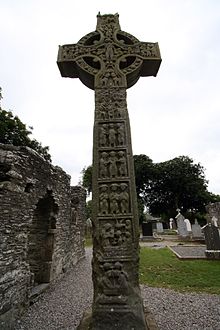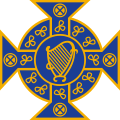켈트 십자: 두 판 사이의 차이
잔글편집 요약 없음 |
|||
| 95번째 줄: | 95번째 줄: | ||
=== 국수주의자들의 사용 === |
=== 국수주의자들의 사용 === |
||
[[File:Neo-Nazi celtic cross flag.svg|thumb|right|150px|국수주의자들의 켈트 십자 깃발.]] |
[[File:Neo-Nazi celtic cross flag.svg|thumb|right|150px|국수주의자들의 켈트 십자 깃발.]] |
||
켈트 십자는 [[민족주의]]와 [[백인 우월주의]]를 나타내는 개인과 단체들이 가장 널리 사용하는 상징물 중 하나이다.<ref>[http://www.adl.org/hate_symbols/racist_celtic_cross.asp "Hate Symbols: Celtic Cross – From A Visual Database of Extremist Symbols, Logos and Tattoos"], ''Anti-Defamation League'', accessed 23 July 2010</ref> 백인 민족주의 사이트인 [ |
켈트 십자는 [[민족주의]]와 [[백인 우월주의]]를 나타내는 개인과 단체들이 가장 널리 사용하는 상징물 중 하나이다.<ref>[http://www.adl.org/hate_symbols/racist_celtic_cross.asp "Hate Symbols: Celtic Cross – From A Visual Database of Extremist Symbols, Logos and Tattoos"], ''Anti-Defamation League'', accessed 23 July 2010</ref> 백인 민족주의 사이트인 [http://Stormfront.org Stormfront]의 로고로 사용되고 있다. |
||
독일에서, 켈트 십자는 금지된 정치정당인 |
독일에서, 켈트 십자는 금지된 정치정당인 [[Volkssozialistische Bewegung Deutschlands/Partei der Arbeit|VSBD/PdA]]가 이를 사용하게 되면서, 인종차별(참고: [https://en.wikipedia.org/wiki/Strafgesetzbuch_section_86a Strafgesetzbuch section 86a])을 홍보하는 맥락에 이를 사용되는것이 금지되었다. 그럼에도 그 금지에 대한 합헌성의 의혹이 있었지만<ref>[http://www.germanlawjournal.com/article.php?id=797 Andreas Stegbauer, "The Ban of Right-Wing Extremist Symbols according to Section 86a of the German Criminal Code"], ''German Law Journal'', No.2, 1 Feb 2007, accessed 22 November 2008</ref> 대법원의 결정으로 유지가 되었다.<ref>[http://juris.bundesgerichtshof.de/cgi-bin/rechtsprechung/document.py?Gericht=bgh&Art=pm&pm_nummer=0209/08 Pressemitteilung Nr. 209/08]</ref> |
||
이탈리아에서도 ''레제 만치노''(Legge Mancino)에서 발생한 유사한 금지가 있으며<ref>[http://host.uniroma3.it/progetti/cedir/cedir/Lex-doc/It_l_205-1993.pdf Legge 205/1993]</ref> (''만치노 법령'', 내무부 장관이 법으로 제정함), 그럼에도 [[이탈리아 북부]]에서는 [[로마 카톨릭 교회]]의 상징물로서 켈트 십자가 일부 사용되고 있다. |
이탈리아에서도 ''레제 만치노''(Legge Mancino)에서 발생한 유사한 금지가 있으며<ref>[http://host.uniroma3.it/progetti/cedir/cedir/Lex-doc/It_l_205-1993.pdf Legge 205/1993]</ref> (''만치노 법령'', 내무부 장관이 법으로 제정함), 그럼에도 [[이탈리아 북부]]에서는 [[로마 카톨릭 교회]]의 상징물로서 켈트 십자가 일부 사용되고 있다. |
||
2014년 6월 25일 (수) 16:57 판
이 문서에는 한국어로 번역되지 않은 내용이 담겨 있습니다. |


켈트 십자가(영어: Celtic Cross, 아일랜드어: cros Cheilteach[1])는 십자와 원이 교차하여 합해져있는 상징물이다. 각 지방마다 표현 방식이 조금씩 다른데 스코틀랜드 게일어: crois Cheilteach, 웨일스어: croes Geltaidd, 콘월어: krows keltek, 브르타뉴어: kroaz geltek 등으로 표현한다. 님부스와 같은 십자가의 종류에 속한다.[2] 켈트 기독교도 세계에서 십자가와 합해져, 지지대가 없이 돌로 만들어진 십자가이며 일반적으로 장식이 풍부한 하이 크로스로 사용되었다.[3] 켈트 문화 부활 운동의 상징으로서, 보통 하이버노색슨 예술의 모티프와 섞여진 형태로 장식되었으며, 장례 조형물과 그외 용도로 인기를 끌게 되어, 아일랜드를 넘어 현재까지 남게 되었다.
기독교계에서 사용
아일랜드와 영국
아일랜드와 스코틀랜드의 판 십자가와 기둥 십자가의 초기 예로는 다음과 같다.
-
퍼스셔, St Madoes에 있는 스코틀랜드 판 십자가
아일랜드에서 켈트 십자가는 성 파트리치오 또는 다신교에서 전환되던 시절에 성 데클라누스에게서 전래되었다고 하는 전설이 있지만, 그럼에도 불구하고 그 초기 시기에 이를 뒷받침할만한 증거는 나오지 않았다. 성 파트리치오가 다신교도들에게 십자가의 중요성에 대한 생각과 생명을 주는 태양의 가치의 생각를 연결하기 위해 기독교의 십자가와 선 크로스를 합쳤다고 주장된다. 다른 해석으로는 켈트 십자가 원의 위에 위치해있는것이 다신교의 태양을 초월한 패권을 상징한다고 한다고 주장한다.


독특한 하이버노색슨의 기념비적인 하이 크로스를 세운것은 8세기에 시작되었고, 그 이전 시기로도 추측한다. 그들은 초기에는 목제로 만들었을 것이며, 후기에는 아마 금속으로 작업을 했을것이다. 일부 '켈트' 하이크로스에는 오검 문자를 지니기도 했다. Standing crosses in Ireland and areas under Irish influence tend to be shorter and more massive than their Anglo-Saxon equivalents, which have mostly lost their headpieces, and therefore perhaps required the extra strength provided by the ring. Irish examples with a head in Celtic cross form include the Cross of Kells, Ardboe High Cross, the crosses at Monasterboice, and the Cross of the Scriptures, Clonmacnoise, as well as those in Scotland at Iona and the Kildalton Cross, which may be the earliest to survive in good condition. There are surviving free-standing crosses in Cornwall, including St Piran's cross at Perranporth, and Wales.[4] Other stone crosses are found in the former Northumbria and Scotland, and further south in England, where they merge with the similar Anglo-Saxon cross making tradition, in the Ruthwell Cross for example. By about 1200 the initial wave of cross building came in to an end in Ireland.
- 아일랜드에 있는 주목할 만한 켈트 하이크로스는 다음과 같다.
- Ahenny, County Tipperary
- Ardboe County Tyrone
- Carndonagh, County Donegal
- Drumcliff, Co. Sligo
- Dysert O'Dea Monastery, County Clare
- Glendalough County Wicklow St. Kevin's Cross
- Killamery, County Kilkenny
- Fahan, County Donegal
- Monasterboice, County Louth
- Clonmacnoise Cross of the Scriptures, County Offaly
- Clonmacnoise North Cross, County Offaly
- Clonmacnoise South Cross, County Offaly
- Kells, County Meath
- Moone, County Kildare
- 스코틀랜드에 있는 주목할 만한 켈트 하이크로스는 다음과 같다.
- Iona Abbey Crosses
- Inchbraoch Cross
- Kildalton Cross
- Meigle 1 Cross
- St. Martins Cross
유럽 대륙
프랑스
There are similar crosses in France, which some specialists[누가?] think are influenced by those from Ireland. But the correct expression to define the continental crosses is "cross with nimbus" (croix nimbée in French). 프랑스의 디자인은 다르지만 형태적으로 꽤 유사하다. 주로 프랑스 서쪽에서 발견되는데, 노르망디, 브르타뉴, 그리고 리무쟁, 오베르뉴중앙까지 발견된다. 대부분의 것들은 15세기에 만들어졌다. 어떤 것은 루아르 계곡에 있는 오를레앙대성당의 첨탑에서도 볼 수 있다.
In Lower Normandy, in Cotentin, many churches have kept their tombstones decorated with a Celtic cross.[5][6]
-
Normandy, Veules-les-Roses Cross
-
Normandy, Saint-Pierre-en-Port Cross
-
Brittany, Sant-Kadoù Island, Stêr an Intel (Étel river)
-
Auvergne, details of a high cross at Chambon-sur-Lac
-
Normandy, Tombstones in the St Germain church, Flamanville
갈리시아
In Galicia Celtic crosses are usually found atop horreos (granaries) as a protective measure against any kind of evil.[7] They can also be found atop churches, and since the beginning of the 20th century in cemeteries, but they are unusual in cruceiros (high crosses). A very characteristic Galician style[8] combines a Celtic cross with a Celtic simple knot. It is similar to the St Maur cross at Glanfeuil Abbey[9][10] that could have been made between the 9th and the 11th century.
-
Modern copy of the Romanesque Agnus Dei topping the church of Saint Mary Salome, in Santiago de Compostela
-
Gothic cross atop the church of Saint Susanna, in Santiago de Compostela
-
A Latin cross and a Celtic cross atop a Galician hórreo (granary)
-
Celtic crosses topping the sanctuary of a Virxe da Barca ('Our Lady of the Boat'), Muxía
-
Cross topping the church of Saint Lazarus, Santiago de Compostela
발트해 지역

에스토니아에서는 섬 지역(히우마 섬, 사레마 섬)에서 특히 발견된다. 라트비아에서는 태양의 신 사울레(Saule)와 관련이 있다.
현대시대
켈트 문화 부활 운동
19세기 중반 켈트 문화 부활 운동 이후 아일랜드에서 켈트 십자가 사용이 증가했다. In 1853 casts of several historical high crosses were exhibited to interested crowds at the Dublin Industrial Exhibition. In 1857, Henry O'Neill published Illustrations of the Most Interesting of the Sculptured Crosses of Ancient Ireland. These two events stimulated interest in the Celtic cross as a symbol for a renewed sense of heritage within Ireland.
New versions of the high cross were designed as fashionable cemetery monuments in Victorian Dublin in the 1860s. From Dublin the revival spread to the rest of the country and beyond. Since the Celtic Revival, the ringed cross became an emblem of Celtic identity, in addition to its more traditional religious symbolism.[11] Alexander and Euphemia Ritchie, working on the Isle of Iona in Scotland from 1899 to 1940, popularised use of the Celtic Cross in jewellery.[12]
-
Modern Celtic cross of a war monument in Limburg-Dietkirchen, Germany
-
Modern Celtic cross at cimetière du Père-Lachaise, Paris
Since its revival in the 1850s, the Celtic cross has been used extensively as grave markers. This was a departure from medieval usage, when the symbol was more typically used for a public monument. The Celtic cross now appears in jewellery, T-shirts, tattoos, coffee cups and other retail items. Both the Gaelic Athletic Association and the Northern Ireland national football team have used versions of the Celtic cross in their logos and advertising.
-
Former crest of the Gaelic Athletic Association
-
Original crest of the Irish Football Association
국수주의자들의 사용

켈트 십자는 민족주의와 백인 우월주의를 나타내는 개인과 단체들이 가장 널리 사용하는 상징물 중 하나이다.[13] 백인 민족주의 사이트인 Stormfront의 로고로 사용되고 있다.
독일에서, 켈트 십자는 금지된 정치정당인 VSBD/PdA가 이를 사용하게 되면서, 인종차별(참고: Strafgesetzbuch section 86a)을 홍보하는 맥락에 이를 사용되는것이 금지되었다. 그럼에도 그 금지에 대한 합헌성의 의혹이 있었지만[14] 대법원의 결정으로 유지가 되었다.[15]
이탈리아에서도 레제 만치노(Legge Mancino)에서 발생한 유사한 금지가 있으며[16] (만치노 법령, 내무부 장관이 법으로 제정함), 그럼에도 이탈리아 북부에서는 로마 카톨릭 교회의 상징물로서 켈트 십자가 일부 사용되고 있다.
조디악 킬러
미국에서 조디악 킬러는 1969년 8월 1일과 1974년 1월 29일 사이에 여러 신문을 오려 붙인 편지에서 켈트 십자가를 닮은 기호를 이용했다. 범인에 이 기호의 의미는 알 수 없다.
같이 보기
참고
- ↑ Dictionary of Irish Terms
- ↑ 님부스는 성인이나 십자가의 머리 주변에 그려진 원형 방사광상이며, 광륜가 관계있다.
- ↑ Werner 98
- ↑ Langdon, Arthur G. (1896) Old Cornish Crosses. Truro: J. Pollard
- ↑ Frédéric Scuvée, Les croix nimbées du Cotentin in Heimdal n°2, 1971.
- ↑ Stéphane Laîné, Baligan ou les avatars d'un émir », in Remembrances et Resveries, Recueil d'articles en hommage à Jean Batany rassemblés et édités par Huguette Legros, Denis Hüe et Joël Grisward, Orléans, Éditions Paradigme.
- ↑ Mariño Ferro, Xosé Ramón (2010). 《Dicionario de etnografia e antropoloxía de Galiza》 1판. Vigo: Nigra Trea. 212쪽. ISBN 978-84-95364-84-5.
- ↑ "There are many types of (church roof) crosses, but the interlaced ones are the most characteristic and the most flamboyant of all those to be found throughout the country (Galicia). They are made up, in most cases, by a Christian cross of equal arms, not unlike a Pate or Greek cross, with a circle that surrounds it; along with this, the cross is ornamented with interlaces in the way of the purest early Celtic art" ("Hai cruces antefixas de moitos tipos pero son as entrelazadas as máis chamativas e características de todas as que podemos atopar polo país. Están formadas na maior parte dos casos por unha cruz cristiá xeralmente de brazos iguais, do tipo da cruz de paté ou grega, e un circulo que a rodea; xunto con isto está ornamentada cun entrelazado da máis pura arte celta primitiva") Romero, Bieito (2009). 《Xeometrías máxicas de Galicia》. Vigo: Ir Indo. 122–176쪽. ISBN 978-84-7680-639-5.
- ↑ The meaning of the St Maur cross (French)
- ↑ [1]
- ↑ Stephen Walker, "Celtic Revival Crosses", Celtic Arts Website, accessed 22 November 2008
- ↑ "A Brief History of the Ritchies", Alexander Ritchie Website, accessed 20 Nov 208
- ↑ "Hate Symbols: Celtic Cross – From A Visual Database of Extremist Symbols, Logos and Tattoos", Anti-Defamation League, accessed 23 July 2010
- ↑ Andreas Stegbauer, "The Ban of Right-Wing Extremist Symbols according to Section 86a of the German Criminal Code", German Law Journal, No.2, 1 Feb 2007, accessed 22 November 2008
- ↑ Pressemitteilung Nr. 209/08
- ↑ Legge 205/1993
주석
- Werner, Martin (1990). “On the Origins of the Form of the Irish High Cross”. 《Gresta》 (Gesta, Vol. 29, No. 1) 29 (1): 98–110. JSTOR 767104.
- H. Richardson: An introduction to Irish high crosses. 1990, ISBN 0-85342-941-3.
- J. Romilly Allen: Early Christian symbolism in Great Britain and Ireland before the thirteenth century. Whiting, London 1887. Neuauflage als The High Crosses of Ireland. Felinfach: Llanerch 1992, ISBN 0-7661-9262-8.
- Peter Harbison: The high crosses of Ireland. Habelt, Bonn, 3 Baende, 1991.
바깥 고리
- David Dimbleby. 〈Age of Conquest〉. 《Seven Ages of Britain》. 29:16 분. BBC 1. 21 Nov 201에 확인함.
- Community network for people with Celtic interests.
- Celtic Crosses – Symbolism and History.
- Is the Celtic Cross a Pagan Symbol?
- Origins and Design of the Celtic Cross.
- Cornish crosses, by Andrew Langdon
- Stephen Walker, "Celtic Cross History and Symbolism"














